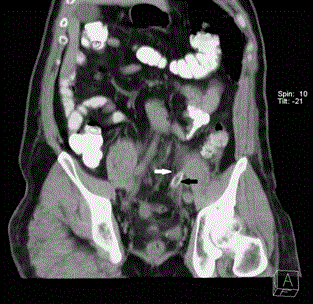Clinical Image
Ureteral Obstruction with an Abdominal Drain
Branko Bogdanić* and Goran Augustin
Department of Surgery, University Hospital Centre Zagreb and School of Medicine, Zagreb, Croatia
*Corresponding author: Branko Bogdanić, Department of Surgery, University Hospital Centre Zagreb and School of Medicine, Zagreb, Croatia
Published: 24 Aug, 2018
Cite this article as: Bogdanić B, Augustin G. Ureteral
Obstruction with an Abdominal Drain.
Clin Surg. 2018; 3: 2085.
Clinical Image
A 42-year-old male patient underwent elective sigmoidectomy for adenocarcinoma of the sigmoid colon. Open resection with primary circular stapler anastomosis was performed. A silicon drain was placed on the left side of the abdomen next to the anastomosis. On the third postoperative day, the patient complained of pain in the left lumbar region with expansion in the left lower quadrant of the abdomen. He had flatus, but no stool passage. There was no discharge on the abdominal drain. Leukocytes were 8,47 x 109/L, C-reactive protein 15.4 mg/L, creatinine 120 μmol/L (preoperative 80 μmol/L); other laboratory tests were normal. An emergency computed tomography of the abdomen and pelvis with oral contrast revealed a distended abdominal part of the left ureter, compressed with an abdominal drain. Intraluminally, no calculi were found (Panel: Black arrowhead showing abdominal drain, white arrowhead showing dilated left ureter). There was no leakage of the contrast on the intestinal anastomosis. Abdominal drainage was removed and the patient felt immediate relief. The next day, the patient had a stool passage and creatinine level was 75 μmol/L. On the fifth postoperative day, the patient was discharged from the hospital with uneventful course.

